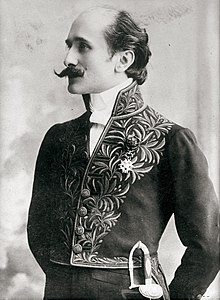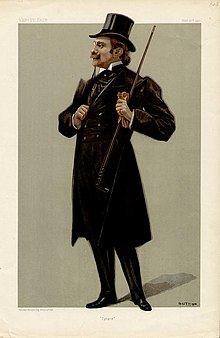Edmond Rostand
Edmond Rostand | |
|---|---|
 Rostand in the uniform of the Académie française, 1905 | |
| Born | Edmond Eugène Alexis Rostand 1 April 1868 Marseille,France |
| Died | 2 December 1918(aged 50) Paris, France |
| Occupation | Poet, playwright |
| Literary movement | Neo-romanticism |
| Spouse | Rosemonde Gérard |
| Children | Jean Rostand Maurice Rostand |
Edmond Eugène Alexis Rostand(UK:/ˈrɒstɒ̃/,[1]US:/rɔːˈstɒ̃,ˈrɒstænd/,[2][3]French:[ɛdmɔ̃ʁɔstɑ̃];1 April 1868 – 2 December 1918) was a French poet and dramatist. He is associated withneo-romanticismand is known best for his 1897 playCyrano de Bergerac.Rostand's romantic plays contrasted with thenaturalistictheatre popular during the late nineteenth century. Another of Rostand's works,Les Romanesques(1894), was adapted to the 1960musical comedyThe Fantasticks.
Early life[edit]
Rostand was born inMarseille,France, into a wealthy and culturedProvençalfamily. His father was an economist, a poet who translated and edited the works ofCatullus,[4]and a member of the Marseille Academy and theInstitut de France.Rostand studied literature, history, and philosophy at theCollège Stanislasin Paris, France.
Career[edit]
When Rostand was twenty years old, his first play, a one-act comedy,Le Gant rouge,was performed at theCluny Theatre,24 August 1888, but it was almost unnoticed.[4]
He and his fiancée Rosemonde Gérard became friends withEmmanuel Chabrierin 1889, and the composer quickly set three of his poems (and two of hers) to music;[5]the following year the two collaborated onÀ la musiquefor the house-warming of a mutual friend.[6]In 1890, Rostand published a volume of poems calledLes Musardises.[7]The same year he offered a one-act Pierrot play in verse to the director of the Théâtre François. This gave him the opportunity to write for the state theatre a three-act play, also in verse, as are all Rostand's plays. He considered himself a poet, whether writing plays or poetry.
The resulting play,Les Romanesques,was produced at the Théâtre François on 21 May 1894. It was a great success and was the start of his career as a dramatist. This play would be adapted in 1960 byTom JonesandHarvey Schmidtinto the long-running American musicalThe Fantasticks.
Rostand's next play was written forSarah Bernhardt.La Princesse Lointainewas based on the story of the 12th-century troubadourJaufre Rudeland his love forHodierna of Jerusalem(who is the archetypalprincesse lointainecharacter). This idealistic play opened on 5 April 1895, at theThéâtre de la Renaissance.The part of Melisandre (based on Hodierna's daughterMelisende of Tripoli) was created bySarah Bernhardt[8]but the play was not particularly successful. When Bernhardt performed it in London later the same year, it received a bad review fromGeorge Bernard Shawbut this was not surprising considering Shaw's bias for realism.[4]Rambaldo di Vaqueiras: I Monferrato,1922 1922 verse drama byNino Berrini(it)is based onLa Princesse Lointaine.
Bernhardt, undeterred, asked Rostand to write another play for her. She created the role of Photine inLa Samaritaine(Theatre de la Renaissance, 14 April 1897), a Biblical drama in three scenes adapted from the gospel story of the woman of Samaria.[8]This play was more successful and became part of Sarah Bernhardt's repertoire. Rostand felt satisfied that he had proven to the public that he was something more than a writer of comedies.[4]

The production of his heroic comedyCyrano de Bergerac(28 December 1897, Théâtre de la Porte Saint-Martin), withBenoît-Constant Coquelinin the title role, was a triumph.[8]The first production lasted for more than 300 consecutive nights.[4]No such enthusiasm for a drama in verse had been known since the time ofHugo'sHernani.The play was quickly translated intoEnglish,German,Russianand other European languages.[8]Cyrano de Bergerac had been a boyhood hero of Rostand, who loved his idealism and courage. He had also thoroughly researched French 17th-century history.
The playL'Aiglonwas written for Sarah Bernhardt to perform during the Exposition Universelle in Paris. A patriotic subject was required, and Rostand chose a subject from Napoleonic history, suggested probably byHenri Welschinger'sRoi de Rome, 1811–32(1897), which contained much new information about the unhappy life of theDuke of Reichstadt,son of Napoleon I, and Marie Louise, surveilled by agents ofMetternichat theSchönbrunn Palace.L'Aiglon,a verse drama in six acts, was produced (15 March 1900) by Sarah Bernhardt at her own theatre, she herself performing the trouser role of the Duke of Reichstadt.[9][8]
In 1901, Rostand became the youngest writer ever to be elected to theAcadémie française.[10]He relocated to Cambo-les-bains, in the Basque Pyrenees, in 1903 for health reasons. Here he built himself a villa, Arnaga (now a Rostand museum) and worked on his next play, one for Constant Coquelin this time,Chantecler.[7]Produced in February 1910, it was awaited with an interest, enhanced by considerable delay in the production, which affected the enthusiasm of its reception. Nor did the Parisian audience enjoy the caricature of salon life in the third act. Since Constant Coquelin had died during rehearsals,Lucien Guitrywas in the title role andMme. Simoneplayed the part of the pheasant.[8]Chantecler is a cockerel and the characters are birds and animals. "Chantecler" is the great play of Rostand's maturity, expressing Rostand's own deepest feelings as a poet and idealist.
The Romancersone act playis one of Edmond Rostand's most famous plays. This play is found to be read for study in the courses of many universities of the world.[11]
When he died prematurely at fifty years old, Rostand was still writing plays. "La Dernière Nuit de Don Juan" was performed posthumously in 1922. There were two unfinished and unpublished plays –YorickandLes Petites Manies.[12]
Personal life[edit]

Rostand was married to the poet and playwrightRosemonde-Étiennette Gérardwho, in 1890, publishedLes Pipeaux:a volume of verse commended by the Academy.[8]The couple had two sons,JeanandMaurice.
During the 1900s, Rostand came to live in the Villa Arnaga inCambo-les-Bainsin the FrenchBasque Country,seeking a cure for hispleurisy.The house is now a heritage site and a museum of Rostand's life andBasquearchitecture and crafts. Rostand died in 1918, a victim of theflu pandemic,and is buried in the Cimetière de Marseille.[9]
Works[edit]
- Le Gant rouge,1888 (The Red Glove)
- Les Musardises,1890
- Les Deux Pierrots,ouLe Souper blanc(The Two Pierrots, or The White Supper), 1891
- Les Romanesques,[13][14]1894 (basis for the 1960 off-Broadway musicalThe Fantasticks)
- La Princesse Lointaine(The Princess Far-Away),[15][16]1895
- La Samaritaine(The Woman of Samaria), 1897
- Cyrano de Bergerac,1897
- L'Aiglon:A Play in Six Acts.1900
- Chantecler: A Play in Four Acts,1910
- La Dernière Nuit de Don Juan(The Last Night of Don Juan, in Poetic Drama), 1921
- Le Cantique de L'Aile,1922
- Le Vol de la Marseillaise,1922
See also[edit]
References[edit]
- ^"Rostand, Edmond".LexicoUK English Dictionary.Oxford University Press.Archived fromthe originalon 31 August 2022.
- ^"Rostand".The American Heritage Dictionary of the English Language(5th ed.). HarperCollins.Retrieved5 August2019.
- ^"Rostand".Merriam-Webster Dictionary.Retrieved5 August2019.
- ^abcdeWilliam Lyon Phelps (1921)Essays on Modern Dramatists,Macmillan, New York
- ^Delage, Roger(1999). Emmanuel Chabrier (in French). Paris: Fayard. ISBN 978-2-213-60508-1. p525f.
- ^Johnson, Graham(2002). Notes to Hyperion CD set CDA67133/4 (Musique adorable! The songs of Emmanuel Chabrier)OCLC1002911049
- ^abAnnual Register for the Year 1918(1919) Longmans, Green and Company, London – New York
- ^abcdefgOne or more of the preceding sentences incorporates text from a publication now in thepublic domain:Chisholm, Hugh,ed. (1911). "Rostand, Edmond".Encyclopædia Britannica.Vol. 23 (11th ed.). Cambridge University Press. p. 754.
- ^ab"Feature: Edmond Rostand".Sydney Theatre Company.1 November 2014. Archived fromthe originalon 28 January 2022.Retrieved2 December2014.
- ^Philip George Hill, ed. (1983).Our Dramatic Heritage Volume 4.Fairleigh Dickinson University Press.p. 365.ISBN9780838632673.
- ^"The Romancers by Edmond Rostand - Class 12 Mero Notice".Mero Notice.23 February 2021.Retrieved27 February2021.
- ^Contemporary Authors Online(2003) Gale, Detroit
- ^Edmond Rostand (1903)Les Romanesques:comédie en trois actes, en vers (Google eBook)(in French)
- ^Edmond Rostand (1915)The Romancers:Comedy in Three Acts, translated by Barrett H. Clark, Samuel French (Google eBook)
- ^Edmond Rostand (1909)La Princesse Lointaine,Charpentier et Fasquelle, Paris (Google eBook)(in French)
- ^Edmond Rostand (1921)The Princess Far-away:A Romantic Tragedy in Four Acts, translated by Anna Emilia Bagstad, R.G. Badger, Boston (Google eBook)
Sources[edit]
- Edmond Rostand:Cyrano de Bergerac,Nick Hern Books,London, 1991.ISBN978-1-85459-117-3
- Henry James in vol. 84, pp. 477 seq.The Cornhill Magazine.
- Marcel Migeo:Les Rostand,Paris, Stock, 1973. About Edmond, his wife Rosemonde, and their sons Jean and Maurice Rostand.
- Sue Lloyd:The Man who was Cyrano, a Life of Edmond Rostand, Creator of 'Cyrano de Bergerac',Genge Press, USA, 2003; UK 2007.ISBN978-0-9549043-1-9
External links[edit]
 FrenchWikisourcehas original text related to this article:Edmond Rostand
FrenchWikisourcehas original text related to this article:Edmond Rostand- Petri Liukkonen."Edmond Rostand".Books and Writers.
- Works by Edmond RostandatProject Gutenberg
- Works by or about Edmond RostandatInternet Archive
- Works by Edmond RostandatLibriVox(public domain audiobooks)

- French text of Rostand'sLa princesse lointaineArchived18 July 2011 at theWayback Machine
- Homerevised web site set up by Genge Press, UK to celebrate Rostand's life and work
- 1868 births
- 1918 deaths
- 19th-century French dramatists and playwrights
- 19th-century French poets
- 20th-century French dramatists and playwrights
- 20th-century French poets
- Collège Stanislas de Paris alumni
- Commanders of the Legion of Honour
- Deaths from the Spanish flu pandemic in France
- Members of the Académie Française
- Writers from Marseille
